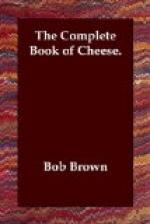Brick is the one and only cheese for which the whole world gives America credit. Runners-up are Liederkranz, which rivals say is too close to Limburger, and Pineapple, which is only a Cheddar under its crisscrossed, painted and flavored rind. Yet Brick is no more distinguished than either of the hundred percent Americans, and in our opinion is less worth bragging about.
It is a medium-firm, mild-to-strong slicing cheese for sandwiches and melting in hot dishes. Its texture is elastic but not rubbery, its taste sweetish, and it is full of little round holes or eyes. All this has inspired enthusiasts to liken it to Emmentaler. The most appropriate name for it has long been “married man’s Limburger.” To make up for the mildness caraway seed is sometimes added.
About Civil War time, John Jossi, a dairyman of Dodge County, Wisconsin, came up with this novelty, a rennet cheese made of whole cow’s milk. The curd is cut like Cheddar, heated, stirred and cooked firm to put in a brick-shaped box without a bottom and with slits in the sides to drain. When this is set on the draining table a couple of bricks are also laid on the cooked curd for pressure. It is this double use of bricks, for shaping and for pressing, that has led to the confusion about which came first in originating the name.
The formed “bricks” of cheese are rubbed with salt for three days and they ripen slowly, taking up to two months.
We eat several million pounds a year and 95 percent of that comes from Wisconsin, with a trickle from New York.
Colorado Blackie Cheese
A subtly different American Cheddar is putting Colorado on our cheese map. It is called Blackie from the black-waxed rind and it resembles Vermont State cheese, although it is flatter. This is a proud new American product, proving that although Papa Cheddar was born in England his American kinfolk have developed independent and valuable characters all on their own.
Coon Cheese
Coon cheese is full of flavor from being aged on shelves at a higher temperature than cold storage. Its rind is darker from the growth of mold and this shade is sometimes painted on more ordinary Cheddars to make them look like Coon, which always brings a 10 percent premium above the general run.
Made at Lowville, New York, it has received high praise from a host of admirers, among them the French cook, Clementine, in Phineas Beck’s Kitchen, who raised it to the par of French immortals by calling it Fromage de Coon. Clementine used it “with scintillating success in countless French recipes which ended with the words gratiner au four et servir tres chaud. She made baguettes of it by soaking sticks three-eights-inch square and one and a half inches long in lukewarm milk, rolling them in flour, beaten egg and bread crumbs and browning them instantaneously in boiling oil.”




